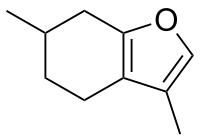Menthofuran
 | |
| Names | |
|---|---|
| IUPAC name
3,6-Dimethyl-4,5,6,7-tetrahydro-1-benzofuran | |
| Identifiers | |
| |
| 3D model (JSmol) |
|
| ChEBI | |
| ChemSpider | |
| ECHA InfoCard | 100.007.087 |
| PubChem CID |
|
| |
| |
| Properties | |
| C10H14O | |
| Molar mass | 150.22 g·mol−1 |
| Except where otherwise noted, data are given for materials in their standard state (at 25 °C [77 °F], 100 kPa). | |
| Infobox references | |
Menthofuran is an organic compound found in a variety of essential oils including that of Pennyroyal. It is highly toxic and believed to be the primary toxin in Pennyroyal responsible for its potentially fatal effects.[1] After ingestion of menthofuran, it is metabolically activated to chemically reactive intermediates that are hepatotoxic.[2]
Methofuran is produced biosynthetically from pulegone by the enzyme menthofuran synthase.
- Menthofuran synthase converts pulegone to menthofuran
Synthesis
Menthofuran was synthesized from 5-methylcyclohexane-1,3-dione and allenyldimethylsulfonium bromide in two steps via a novel furannulation strategy consisting of enolate addition and rearrangement.[3]
References
- ↑ Anderson, IB; Mullen, WH; Meeker, JE; Oishi, S; Nelson, SD; Blanc, PD (1996). "Pennyroyal toxicity: Measurement of toxic metabolite levels in two cases and review of the literature". Annals of Internal Medicine. 124 (8): 726–34. PMID 8633832. doi:10.7326/0003-4819-124-8-199604150-00004. Missing
|last4=in Authors list (help) - ↑ Thomassen, D; Knebel, N; Slattery, JT; McClanahan, RH; Nelson, SD (1992). "Reactive intermediates in the oxidation of menthofuran by cytochromes P-450". Chemical research in toxicology. 5 (1): 123–30. PMID 1581528. doi:10.1021/tx00025a021.
- ↑ Mariko Aso; Sakamoto, Mizue; Urakawa, Narumi; Kanematsu, Ken (1990). "Furannulation strategy. An efficient synthesis of fused 3-methylfurans". Heterocycles. 31 (6): 1003–6. doi:10.3987/com-90-5392.
This article is issued from
Wikipedia.
The text is licensed under Creative Commons - Attribution - Sharealike.
Additional terms may apply for the media files.